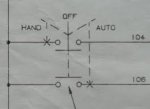That is the old "JIC" schematic representation used in North America, now known as "NEMA" schematics, although NEMA is not really an enforced standard. The other one, using specific numbering of terminals, is the IEC schematic standard derived originally from the German DIN standards.
Topgone is correct, in the IEC standard anything ending in 1-2 is NC, anything ending in 3-4 is NO, then the first digit pertains to its physical location on the device itself. So 13-14 means it is a NO contact on the fist position of the switch, in this case the first tier, left side looking at it from the inside of the panel. 21-22 would be next to it on the right side of the first tier, 33-34 would be NO second tier left side, 43-44 would be NO 2nd tier right side, etc. etc., based on the switch holding only two contact blocks per tier. If the switch holds 3 per tier, as Siemens switches do, the physical location changes slightly, but the standard is still very specific as to what that is (I can't remember though if it is 1, 2, 3 left to right, or 1, 3, 2, because that puts 1 and 2 as always being in the same spot regardless of brand). It's actually a very "rational" system (as the Germans like to say) once you are taught (and can remember) how it works.



